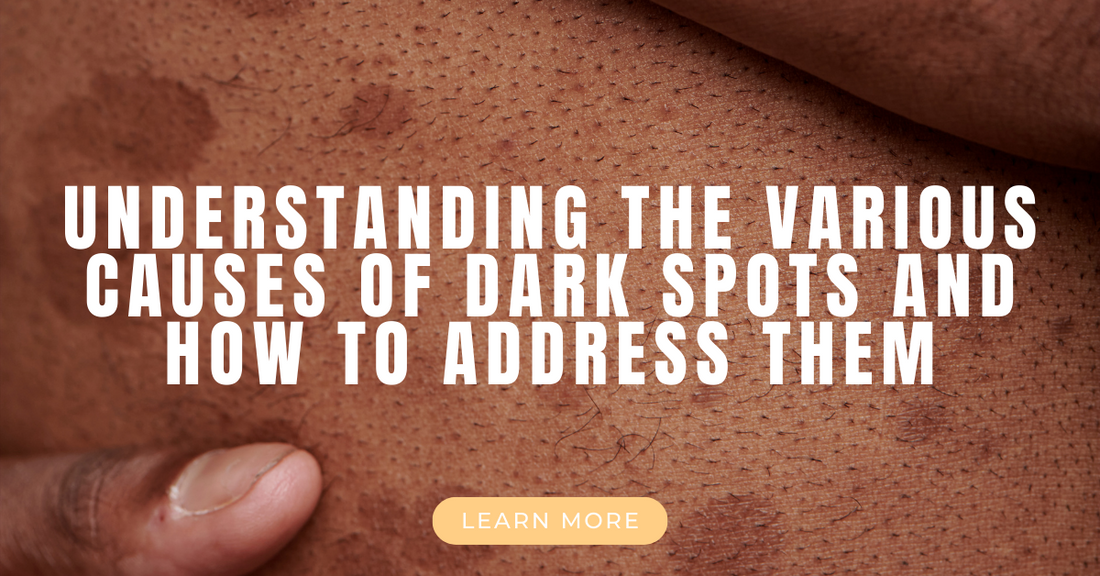
Understanding the Various Causes of Dark Spots and How to Address Them
Share
Introduction
Dark spots, also known as hyperpigmentation, are a common skin concern that can affect people of all ages and skin types. These pesky blemishes can be caused by a variety of factors, including sun exposure, hormonal changes, and skin injuries. In this blog post, we'll explore the different causes of dark spots and provide you with some tips on how to address and prevent them.
- Sun Exposure
One of the primary causes of dark spots is sun exposure. When your skin is exposed to the sun's harmful UV rays, it produces more melanin, a pigment that gives your skin its color. Over time, this can lead to the development of dark spots, also known as sunspots or age spots.
How to Address Sun-Induced Dark Spots:
- Wear sunscreen daily: Apply a broad-spectrum sunscreen with at least SPF 30 to protect your skin from UV damage.
- Use protective clothing: Wear hats, sunglasses, and long-sleeved clothing to shield your skin from the sun.
- Seek shade: Avoid prolonged sun exposure, especially during peak hours between 10 a.m. and 4 p.m.
- Consider topical treatments: Products containing ingredients like niacinamide, vitamin C, and retinoids can help fade existing sunspots.
- Hormonal Changes
Hormonal fluctuations, such as those that occur during pregnancy, menopause, or while taking birth control pills, can trigger the development of dark spots. This type of hyperpigmentation is often called melasma.
How to Address Hormonal Dark Spots:
- Consult a dermatologist: If you suspect hormonal changes are causing your dark spots, seek professional advice for tailored treatment options.
- Use gentle skincare: Opt for skincare products that are safe for sensitive skin and avoid harsh exfoliants or chemical peels that can worsen melasma.
- Sun protection: Sunscreen is crucial in preventing melasma from worsening, as UV exposure can exacerbate the condition.
- Skin Injuries and Inflammation
Dark spots can also develop as a result of skin injuries, such as acne, cuts, or burns. These spots are known as post-inflammatory hyperpigmentation (PIH).
How to Address PIH:
- Treat the underlying condition: Address the root cause, such as acne or skin irritation, to prevent further dark spots from forming.
- Be patient: PIH can fade over time, but it may take several months or even years. Consistent skincare and sun protection are key.
- Use topical treatments: Ingredients like alpha hydroxy acids (AHAs), beta hydroxy acids (BHAs), and vitamin C can help lighten PIH.
- Age and Genetics
As we age, our skin's ability to repair and regenerate itself diminishes, making it more prone to dark spots. Additionally, genetics can play a role in predisposing some individuals to hyperpigmentation.
How to Address Age-Related Dark Spots:
- Incorporate antioxidants: Antioxidant-rich skincare products can help combat the effects of aging and prevent further dark spots.
- Maintain a consistent skincare routine: Regular cleansing, moisturizing, and exfoliating can promote healthier-looking skin.
- Consult a dermatologist: For stubborn age-related dark spots, consider professional treatments like chemical peels, microdermabrasion, or laser therapy.
Conclusion
Dark spots can be frustrating, but with the right approach, they can be managed and minimized. Remember that prevention is often easier than treatment, so always prioritize sun protection and gentle skincare. If you're struggling with stubborn dark spots, consult a dermatologist for personalized advice and treatment options tailored to your specific needs. By addressing the root causes and following a diligent skincare routine, you can achieve a more even and radiant complexion.